by Michael R. Allen
 Left: 2944 Sheridan Avenue, abandoned and owned by the city’s Land Reutilization Authority. Right: 2946 Sheridan, privately owned and well maintained. Left to right: one historic building in the city’s JeffVanderLou neighborhood.
Left: 2944 Sheridan Avenue, abandoned and owned by the city’s Land Reutilization Authority. Right: 2946 Sheridan, privately owned and well maintained. Left to right: one historic building in the city’s JeffVanderLou neighborhood.
by Michael R. Allen
The sight of abandoned buildings less than thirty years old can be particularly unsettling. Urban housing that has been built and abandoned within a thirty year time frame tells a tale of acute failure. Blame it on the design, cheap construction, bad tenants or shady landlords — no matter. That a society can discard relatively new buildings shows fundamental problems with our values.
These buildings in JeffVanderLou are good examples.
 The two-story apartment building at 3032 Sheridan Avenue was built in 1980 and boarded up in 2008. The owner is JVL 1998 Apartments LLC, whose organizers are Mark Jaffe and Martin Jaffe according to the Secretary of State’s Office. The frame building stands on a concrete foundation. While not particularly attractive, the scale, fenestration and setback are fairly urban. The high basement creates another level of living space and maxinmizes density — perhaps that is too much when there are not separate external entrances?
The two-story apartment building at 3032 Sheridan Avenue was built in 1980 and boarded up in 2008. The owner is JVL 1998 Apartments LLC, whose organizers are Mark Jaffe and Martin Jaffe according to the Secretary of State’s Office. The frame building stands on a concrete foundation. While not particularly attractive, the scale, fenestration and setback are fairly urban. The high basement creates another level of living space and maxinmizes density — perhaps that is too much when there are not separate external entrances?
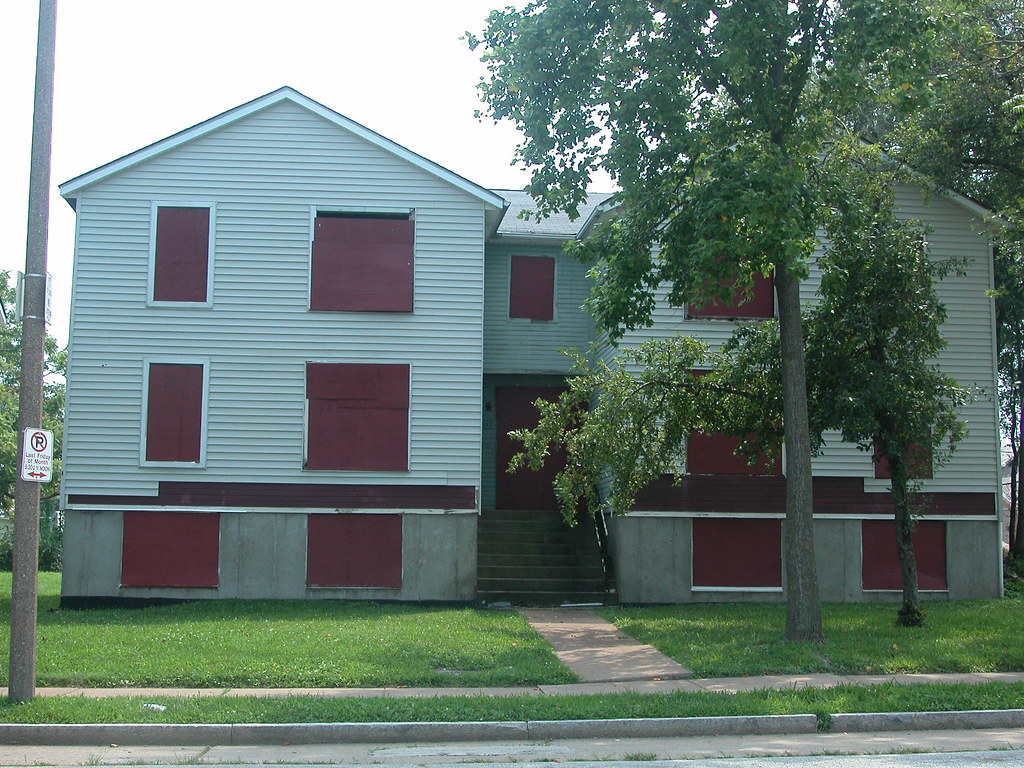 The two-story apartment building at 3042 Sheridan Avenue was built in 1980 and vacated in 2002. The owner is JVL 1998 Apartments LLC. Even smaller than its next-door neighbor, this building is not doomed by its decent (not great) design.
The two-story apartment building at 3042 Sheridan Avenue was built in 1980 and vacated in 2002. The owner is JVL 1998 Apartments LLC. Even smaller than its next-door neighbor, this building is not doomed by its decent (not great) design.
 This pair of two-story apartment buidlings on platform founations stands east of the other two, at 148 and 1418 Glasgow Avenue. City records indicate that these buildings were built in 1978. Now owned by the city’s Land Reutilization Authority, the buildings were owned in 2007 by JVL Affordable Housing LP, a subsidiary of Austin, Texas-based Delphi Affordable Housing Group. Delphi must have defaulted on its property taxes here. Delphi purchased these and dozens more in JVL, St. Louis Place and JeffVanderLou from an Arizona-based company in 2005. The Arizona company had run the properties in the ground. Delphi rehabilitated most of its inventory, but many of its buildings again have become the source of frequent citizen complaints about nuisances and drug dealing.
This pair of two-story apartment buidlings on platform founations stands east of the other two, at 148 and 1418 Glasgow Avenue. City records indicate that these buildings were built in 1978. Now owned by the city’s Land Reutilization Authority, the buildings were owned in 2007 by JVL Affordable Housing LP, a subsidiary of Austin, Texas-based Delphi Affordable Housing Group. Delphi must have defaulted on its property taxes here. Delphi purchased these and dozens more in JVL, St. Louis Place and JeffVanderLou from an Arizona-based company in 2005. The Arizona company had run the properties in the ground. Delphi rehabilitated most of its inventory, but many of its buildings again have become the source of frequent citizen complaints about nuisances and drug dealing.
by Michael R. Allen
In the center of the Pruitt-Igoe Nature Preserve, also known as the undeveloped section of the site of the Pruitt and Igoe housing projects, there is is a central east-west access road running from Jefferson Avenue east, then bending north to Cass Avenue. Another northern spur also leads to Cass. The odd thing is that each view outward down the main path and the view outward down the northern spur are closed by churches, marked on this aerial photograph from the Geo St. Louis website.
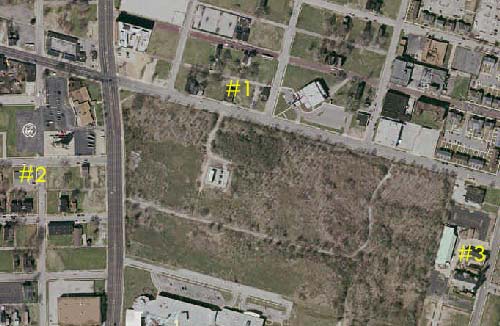
Church #1 is True Grace Baptist Church, a storefront-style worship space at 2319 Cass Avenue.
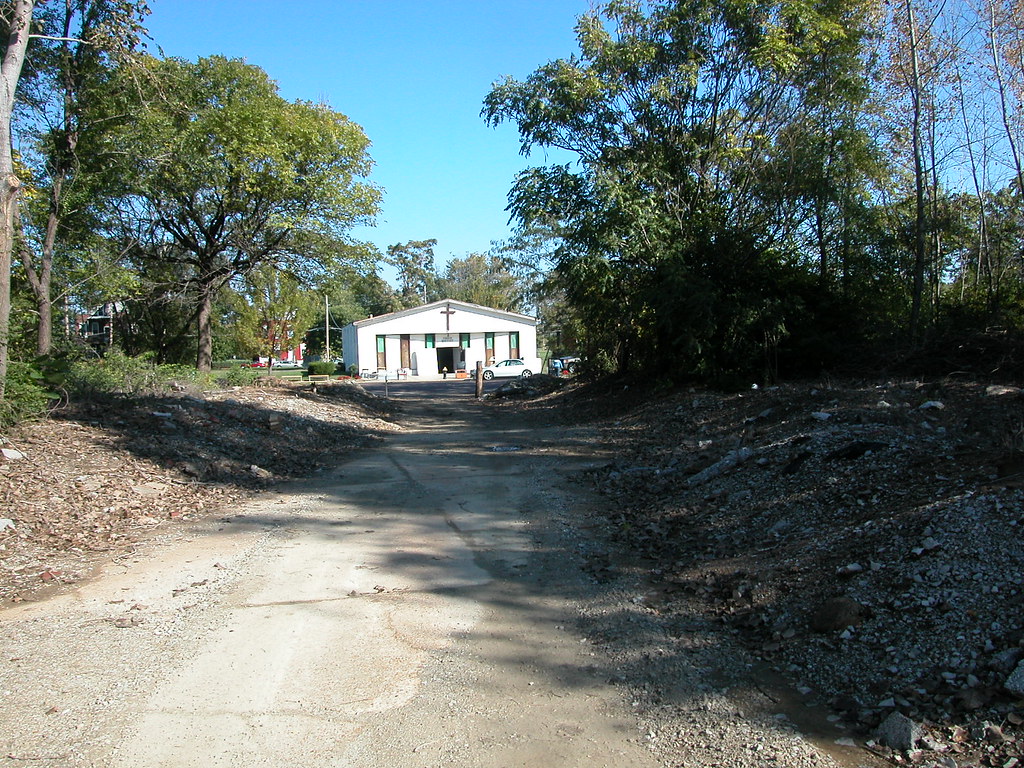
Church #2 is actually one block west from the Pruitt-Igoe site, but there are no intervening buildings to block the view. This is Zion Temple Missionary Baptist Church at 2700 Thomas Avenue.

Church #3 is the famous St. Stanislaus Kostka Church at 1413 N. 20th Street, which pre-dates the construction of Pruitt-Igoe by over a half-century.
The other northern-leading path’s view terminates at the rear of the Mullanphy Tenement, visible across the parking lot of the Absorene Company.
The Pruitt-Igoe grounds hold both the history of the failed but once proud housing projects as well as years of dumped debris. The layers of fill and remains have not stopped healthy vegetation, and much of the site resembles a nature preserve. the access roads, which are largely clear, gives the site’s wild state a sense of intention. The presence of the three churches closing the long views down these paths adds serenity to the scene. The churches’ presence on the margins of the Pruitt-Igoe site call to mind the notion of redemption. In its current state, the Pruitt Igoe site seems to have cleansed its historical wounds and reconciled with nature. The site’s current ecological state is wholly new and supportive of new life. Has this tortured land met its redemption?
UPDATE: Reader Bill Michalski sent me a still frame from the film Koyaanisqatsi, where True Grace Baptist Church is evident in footage taken in 1972.
by Michael R. Allen
 Look at the west face of the 2900 block of North 13th Street in Old North in April 2005. While only one building was occupied, we had a solid, uninterrupted row of historic buildings running from Sullivan Avenue north to Hebert Street. I took this photograph while house hunting, and looked at it frequently to confirm that my decision to purchase a house on Sullivan across the street from Fourth Baptist Church (right at the corner) was a good one. Some would have run away from the prospect of living in close proximity to an unhealthy row, no matter how beautiful its individual buildings were. I was intrigued by the possibility of glorious renewal.
Look at the west face of the 2900 block of North 13th Street in Old North in April 2005. While only one building was occupied, we had a solid, uninterrupted row of historic buildings running from Sullivan Avenue north to Hebert Street. I took this photograph while house hunting, and looked at it frequently to confirm that my decision to purchase a house on Sullivan across the street from Fourth Baptist Church (right at the corner) was a good one. Some would have run away from the prospect of living in close proximity to an unhealthy row, no matter how beautiful its individual buildings were. I was intrigued by the possibility of glorious renewal.
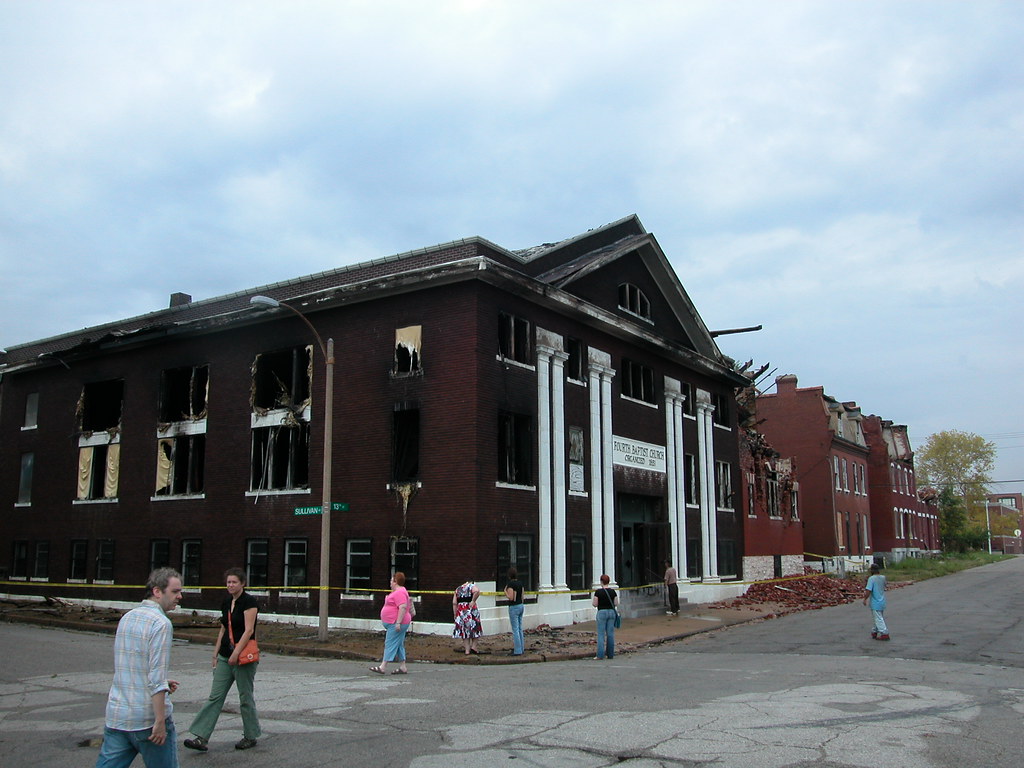 That possibility has closed in the three years since I took the photograph. The building show in the first photograph at right is unchanged, but the west side of the street barely resembles even its scarred former self. Fourth Baptist Church burned on September 20, 2008, and shows severe damage. The four-flat north of the church and its annex was occupied in April 2005 but now is vacant and boarded. Someone stole its cast iron fence a few weeks ago. Beyond that house is the row of city-owned buildings that were hit by partial roof collapse in February 2008 and devastating fire in July 2008. I think that the south side of the row is savable, but the north end is past the point where its salvage is likely. (I do think that its ruined brick walls could become part of new construction.) Past the row, the old Dummitt’s Confectionery building disappeared right after I took this photograph.
That possibility has closed in the three years since I took the photograph. The building show in the first photograph at right is unchanged, but the west side of the street barely resembles even its scarred former self. Fourth Baptist Church burned on September 20, 2008, and shows severe damage. The four-flat north of the church and its annex was occupied in April 2005 but now is vacant and boarded. Someone stole its cast iron fence a few weeks ago. Beyond that house is the row of city-owned buildings that were hit by partial roof collapse in February 2008 and devastating fire in July 2008. I think that the south side of the row is savable, but the north end is past the point where its salvage is likely. (I do think that its ruined brick walls could become part of new construction.) Past the row, the old Dummitt’s Confectionery building disappeared right after I took this photograph.
The worst case scenario for the west face of this block is loss of all but the four-flat next door to the church. What a strange landscape that would be, but one joining the legions of such obscene wounds throughout Old North, St. Louis Place, JeffVanderLou, The Ville and other north side neighborhoods. No block of mostly-vacant buildings is immune. Possibility is latent in all of the city’s historic architecture, but its realization is not. Realization takes an effort unlike any ever seen in St. Louis before.
Old North is blessed to have residents committed to healing the wounds and a community development corporation that has already healed a few. Many north side residents strive to emulate that energy in their neighborhoods. But the 2900 block of North 13th Street shows us the limits of even the most boundless energy when that energy does not have access to massive capital.
My whole sense of place is changing as the built world across the street from my front door disappears. I still see possibility, but I also sense limits more strongly. Everyone in Old North has lost some part of what defines their place in the world, and some long-time residents barely know what Old North is these days. Yes, neighborhoods are collections of people, but without buildings people have nowhere to live, work, worship or shop. And they leave — along with their money.
Things seem relatively better now only because we lost so much of our near north neighborhoods in the past fifty years. Losing more is unacceptable, and we need to step up our efforts to safeguard what is left — and build back the places for human life that we have lost. Look at what happened to one block, and think about how that process has repeated itself on blocks across the north side for over a half-century. We have lost buildings, people, blocks and entire neighborhoods. In the process, we have let half of the city become the biggest development challenge in the region, and made its resource-deprived residents nearly second-class St. Louisans. Our cultural attitudes and political system enshrine the deprivation of north St. Louis.
When do we make it stop?
by Michael R. Allen
 This post is a frustrating and sad one to write, even though its eventuality has crossed my mind before. Living across the street from the church, I have felt deep sorrow and needed time to grieve before writing about this weekend’s tragedy.
This post is a frustrating and sad one to write, even though its eventuality has crossed my mind before. Living across the street from the church, I have felt deep sorrow and needed time to grieve before writing about this weekend’s tragedy.
On Saturday morning at around 9:45 a.m., a large fire erupted at the vacant Fourth Baptist Church at the northwest corner of 13th and Sullivan avenues in Old North St. Louis. After several hours, firefighters extinguished a fire that left the three buildings of the complex in various states of instability, a small congregation with a huge difficulty and a neighborhood that has enjoyed much progress and positive publicity with a stern reminder of the reality of urban abandonment. The congregation moved out in 2002 after a boiler break-down, and has not been able to find funds to repair the building and return. Nor has a buyer been found for the church complex, which needed extensive rehabilitation. Now Fourth Baptist joins plentiful ranks of the near north side’s many handsome institutional buildings wrecked by fire and severe weather.
No one yet knows the fire’s cause, which is under investigation. Although the church has been unsecured in recent months (see “How Now to Board Up a Broken Window,” February 27, 2008), Fourth Baptist had been tightly boarded for the last six months. Usual points of entrance in the rear seemed secure after the fire was over. Still, neighborhood speculation fingers ever-present metal thieves working with torches or other spark-creating devices, arsonists looking for kicks and brick thieves looking to get a new project underway. Another possible cause is the electrical service, which may or may not have still been live on Saturday. (The service was active as recently as winter 2007.)
As with other landmarks left similarly crippled, cause is not as important as result. Fourth Baptist’s condition had been stable; there were small roof failure points and minor masonry issues, but overall the buildings comprising the church complex — four in number — were intact and clearly ready for renovation. The fire leaves behind an uncertain structural condition yet to be formally assessed. Some damage is obvious: the roof structure of the sanctuary is damaged badly at the crest, and the interior wood structure seems severely compromised; the “annex” (actually an older sanctuary later expanded) had half of its front elevation knocked off by firefighters’ aggressive hose work; there is a hole in the old house at 1309 Sullivan Avenue connected to the church. However, much stability is obvious, too.
The city is poised to issue an emergency demolition order, which Fourth Baptist pastor Richard Taylor vows to fight. The condition of the three buildings absolutely does not warrant demolition of the entire complex, as examination of the individual parts makes clear.
Sanctuary
 The sanctuary, completed in 1924 in a modern Greek Revival style, is one of the starkest and most urban churches in north city. The dark machine-raked brick walls are placed right at the sidewalk line, with simple white terra cotta pilasters and spandrels providing ornament. The congregation made the best use of a constrained site, building the whole plot out to connect with an adjacent house and their earlier building. This is anathema to today’s climate, where city churches build mega-plexes with pristine green lawns and plenty of parking.
The sanctuary, completed in 1924 in a modern Greek Revival style, is one of the starkest and most urban churches in north city. The dark machine-raked brick walls are placed right at the sidewalk line, with simple white terra cotta pilasters and spandrels providing ornament. The congregation made the best use of a constrained site, building the whole plot out to connect with an adjacent house and their earlier building. This is anathema to today’s climate, where city churches build mega-plexes with pristine green lawns and plenty of parking.
 The fire hit the sanctuary the hardest of the buildings, although its robust masonry walls were scarcely scratched. Alas, the sanctuary seems to have been fully gutted by the fire, with wooden joists and floorboards scorched beyond salvage in many places. Given the age of the building, it’s possible that steel beams were used across the floor joists. Even the ornamental soffit running along Sullivan Avenue was not completely destroyed. What is most troubling is that the roof suffered intense heat, and most of its shingles burned away or fell off. The exposed decking shows sections near the crest that are gone, other areas that are severely burned, and some sections that are intact. The trusses on the western end are failing, but those on the eastern half seem solid.
The fire hit the sanctuary the hardest of the buildings, although its robust masonry walls were scarcely scratched. Alas, the sanctuary seems to have been fully gutted by the fire, with wooden joists and floorboards scorched beyond salvage in many places. Given the age of the building, it’s possible that steel beams were used across the floor joists. Even the ornamental soffit running along Sullivan Avenue was not completely destroyed. What is most troubling is that the roof suffered intense heat, and most of its shingles burned away or fell off. The exposed decking shows sections near the crest that are gone, other areas that are severely burned, and some sections that are intact. The trusses on the western end are failing, but those on the eastern half seem solid.
 The sanctuary’s walls are in no danger of collapse. The 2004 theft and return of the church’s stained glass windows led to their storage elsewhere, so all but one that remained are intact. One possibility for the sanctuary is swift repair of the roof and boarding of all openings; such mothballing could buy time. Another option is removal of all wooden structural elements and bracing of the masonry walls, but that only makes sense of permanent stabilization would come in the near future.
The sanctuary’s walls are in no danger of collapse. The 2004 theft and return of the church’s stained glass windows led to their storage elsewhere, so all but one that remained are intact. One possibility for the sanctuary is swift repair of the roof and boarding of all openings; such mothballing could buy time. Another option is removal of all wooden structural elements and bracing of the masonry walls, but that only makes sense of permanent stabilization would come in the near future.
Annex
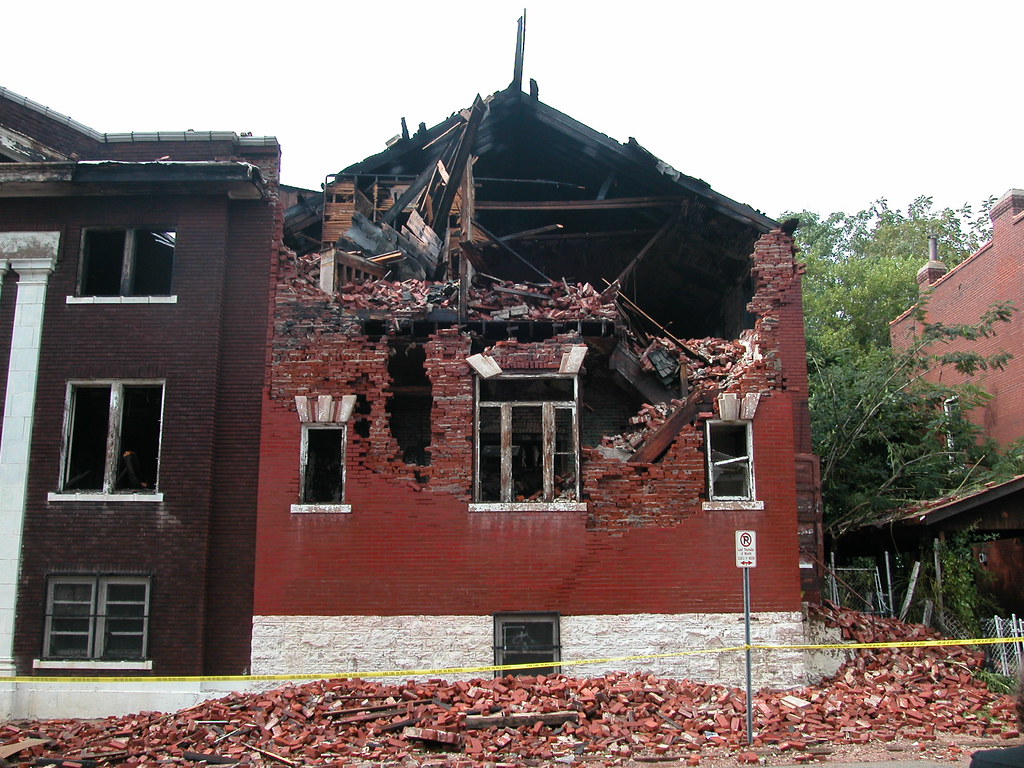 The “annex” north of the sanctuary on 13th street is actually an earlier sanctuary. Fourth Baptist had its start in 1859 on the site now occupied by Grace Hill’s campus. In 1892, the church hired architects Matthews, Clarke and James to design a one-story front-gabled church at this site. That building, became the first story of the present annex. In 1937, after completing the new sanctuary, the congregation raised this building up one story and combined the sections with an orange-brick Georgian Revival front elevation. Through the windows of the first floor, one can see the original front wall of the church. The structure served as the Sunday school and church office, among other things.
The “annex” north of the sanctuary on 13th street is actually an earlier sanctuary. Fourth Baptist had its start in 1859 on the site now occupied by Grace Hill’s campus. In 1892, the church hired architects Matthews, Clarke and James to design a one-story front-gabled church at this site. That building, became the first story of the present annex. In 1937, after completing the new sanctuary, the congregation raised this building up one story and combined the sections with an orange-brick Georgian Revival front elevation. Through the windows of the first floor, one can see the original front wall of the church. The structure served as the Sunday school and church office, among other things.
The annex suffered the worst damage of the church buildings, but not necessarily due to the fire. The fire damaged the roof structure and second floor, but did not cause the second floor wall to collapse outward. While the roof fire ate away the wall’s connection to the roof, the pressurized spray of fire hoses after the fire was largely extinguished caused the wall to fall outward into the street.
Unfortunately, that damage may lead to the sure loss of this section. Without a plan for rebuilding the front section, or some temporary shoring, weather and wind will cause further failure of this building. Neighbors have banded together to remove and safely store bricks piled at the base of the building, in case rebuilding will ever begin.
1309 Sullivan Avenue This modest brick house with dentillated cornice and side mousehole is shown on Compton and Dry’s 1875 Pictorial St. Louis; construction could date to the late 1850’s. The church acquired the house while building the sanctuary, and connected it internally for use as a parsonage. In 1952, the church built a long two-story addition at rear to house more classrooms and a basement kitchen. That steel-framed section was not significantly damaged by the fire, although it is the only section considered noncontributing to the Murphy-Blair Historic District. The house seems to have escaped extensive fire damage, although again pressurized spray damaged the masonry on the front elevation, precipitating additional brick loss and weather infiltration.
This modest brick house with dentillated cornice and side mousehole is shown on Compton and Dry’s 1875 Pictorial St. Louis; construction could date to the late 1850’s. The church acquired the house while building the sanctuary, and connected it internally for use as a parsonage. In 1952, the church built a long two-story addition at rear to house more classrooms and a basement kitchen. That steel-framed section was not significantly damaged by the fire, although it is the only section considered noncontributing to the Murphy-Blair Historic District. The house seems to have escaped extensive fire damage, although again pressurized spray damaged the masonry on the front elevation, precipitating additional brick loss and weather infiltration.
Summary
Immediately following the fire, the church complex was boarded back up. However, an immediate need for stabilization and roof repair would prolong the period for careful decision-making. The annex requires an immediate plan for masonry reconstruction and roof repair if it is to survive the coming year. The house at 1309 Sullivan, meanwhile, would survive indefinitely with immediate masonry repair of the front elevation, secured openings and a new roof. The sanctuary’s walls should be braced immediately.
The Old North St. Louis Restoration Group is still working to complete stabilization and repair of the Mullanphy Emigrant Home, and is an unlikely party to take on ownership of the church. Now seems to be the time for the region’s Baptist churches to rally around Fourth Baptist and help raise the funds needed to stabilize their beleaguered home. Fourth Baptist’s active membership is probably less than 20, and its financial ability not in the league needed to face this challenge. Still, the story of Fourth Baptist’s buildings should not end with total destruction. At the very least, whatever can be saved should be saved for the future of a neighborhood Fourth Baptist has called home for nearly 150 years.
by Michael R. Allen
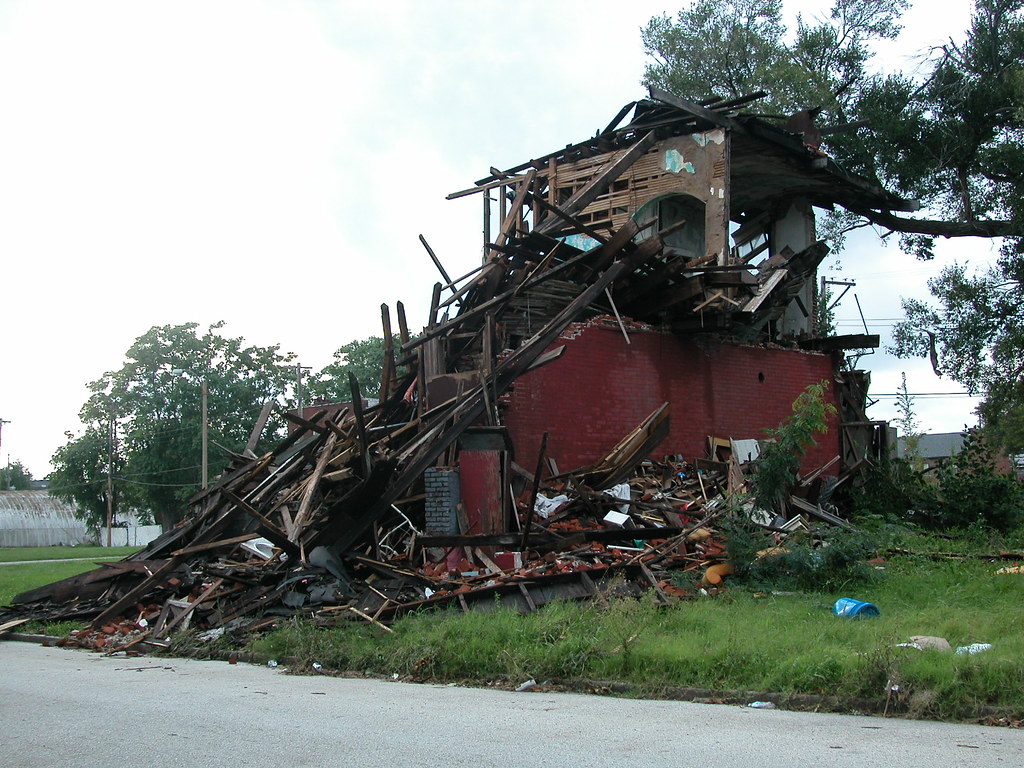 One gets the sense that the city of St. Louis cannot get a high wind without having a historic north side building crippled. This weekend, the remnants of Ike struck Old North St. Louis, causing more damage. Oddly, soon afterwards a truckload of St. Louis firemen arrived and struck the buidling with pressurized water spray for minutes, delving the final blow to the long-suffering house at 1219 Clinton Street. No one knows why the Fire Department showed up and performed pointless and destructive work. The vacant house had its first major blow back in the freak storm of July 2006. (See “A Dying House on Clinton Street”, July 11, 2008.)
One gets the sense that the city of St. Louis cannot get a high wind without having a historic north side building crippled. This weekend, the remnants of Ike struck Old North St. Louis, causing more damage. Oddly, soon afterwards a truckload of St. Louis firemen arrived and struck the buidling with pressurized water spray for minutes, delving the final blow to the long-suffering house at 1219 Clinton Street. No one knows why the Fire Department showed up and performed pointless and destructive work. The vacant house had its first major blow back in the freak storm of July 2006. (See “A Dying House on Clinton Street”, July 11, 2008.)
Whereas some semblance of the front elevation remained intact throughout years of eroding fabric, now the house is a barely recognizable pile of materials destined for demolition. The loss had been inevitable for some time, although the opportunity for prevention was within reach until quite recently. The trouble with old buildings is that their economic rescue is calculated in price per square of rehabilitation, and once a building slips past a certain price it passes beyond the point of profit or even break-even. If a developer cannot break even, the only imperative for rehabilitation is a moral one. Even those who wish to lose money doing the right thing cannot do so if they don’t have the money. No bank will finance a project that creates negative equity, no matter how much money the building could be worth in ten years.
The house on Clinton had passed the reasonable price-per-square-foot point awhile ago. Compounding its problems is the fact that it’s the last house left on its block, and the other side of its block is faced with residences built in the 1980s.
Contrast the house on Clinton with some of the recent products of the ongoing Crown Square project. Four buildings on the 1300 and 1400 blocks of Warren Street are completed. Looking at the photographs below, one sees that these houses fit into streetscapes of other historic buildings. While these blocks are not fully intact, they are intact to the extent where further loss would be much more harmful than the loss of a single house on a block.

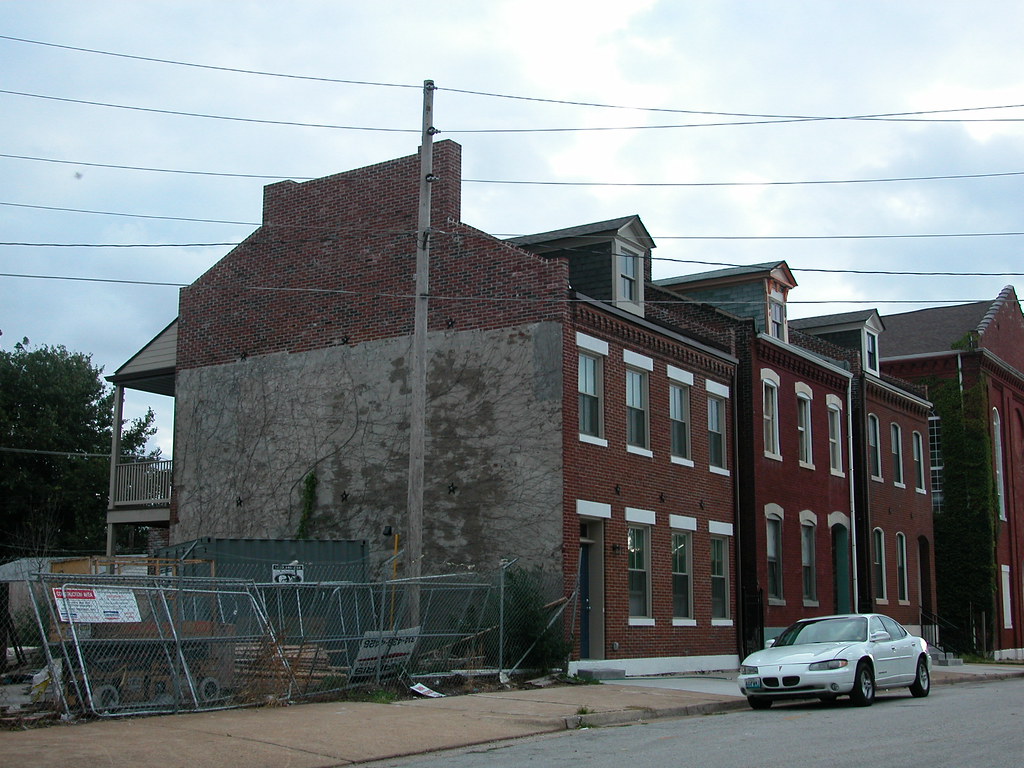
With limited funds available and the rules of finance at play, most developers are going to select to rehab buildings like those on Warren over the house on Clinton. By doing so, these developers aren’t doing anything wrong. In fact, many bankers and developers would not even touch houses like those on Warren. The developers who did were non-profit organizations (the Regional Housing and Community Development Alliance and the Old North St. Louis Restoration Group). If it takes a non-profit to rehab the houses on Warren right now, it would have taken a charity to tackle the house on Clinton.
None off this explanation justifies the loss of a great house like the one on Clinton Street. Really, the loss could have been prevented if a new roof and boards had been installed three years ago. But who would have picked up the tab? Back then, the house had a private owner who had stopped paying taxes on the property. Alter, the city’s Land Reutilization Authority owned the house. The first part was unwilling to do the right thing, the second unable.
Preservationists would be willing, be we aren’t able. St. Louis lacks a bridge over the the preservation gap between the right thing and the possible thing. Can we build one?
by Michael R. Allen
There seems to be more than a passing resemblance between the Forest Park Southeast hotel designs that Drury Inn presented at a recent neighborhood meeting and the abandoned Lever Soap Plant in Pagedale. The three-dimensional renderings of two hotel buildings planned for a site at the southeast corner of the Kingshighway and I-64/40 interchange are in a conceptual phase, but their apparent industrial inspiration is somewhat encouraging.
Here is a close-up of one of the hotels:
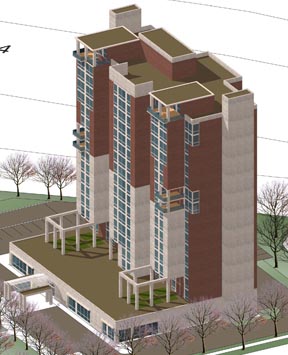
Here is the Lever Plant, a lovely composition of industrial economy:
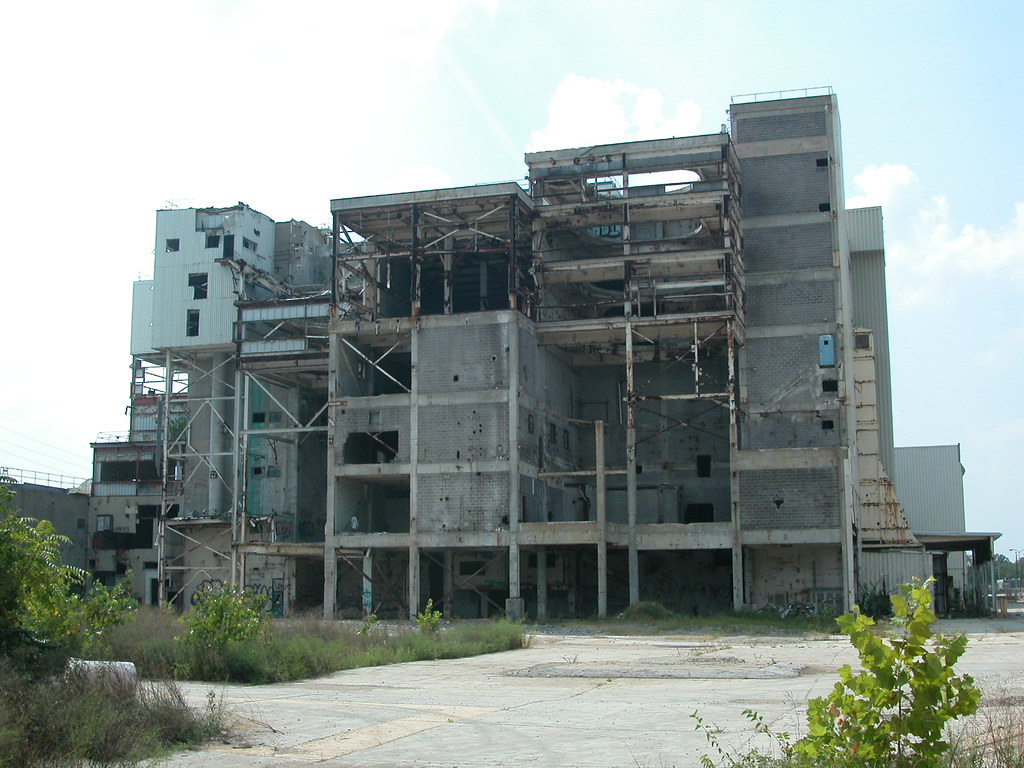 Just sayin’.
Just sayin’.
by Michael R. Allen
Here we see part of the fallout of the current housing market collapse, and a sign that large-scale projects pose only one obvious type of threat to the historic architecture of north St. Louis. This is a tenement house at 1102-4 Montgomery Street in Old North St. Louis, and is best known for the gaping hole in the side wall and giant grafitti tag prominent on Interstate 70.
This poor building’s condition is the result of a rehabilitation scheme gone awry. In 2005, Impact Real Estate Investment purchased this building, a house across the street and a house at the northwest corner of St. Louis Avenue and Hadley streets — all in Old North. Impact also bought buildings in other neighborhoods. Led by Marteese Robinson, former Director of Professional Scouting for the St. Louis Cardinals, the company had big plans.
In an article that appeared in the January 31, 2005 issue of the St. Louis Buisness Journal, Robinson’s redevelopment philosophy is reported:
When he buys a property, Robinson first replaces the roof and then guts the interior. When renovating the homes, he tries to maintain as many historic details as he can, recycling ornate woodwork and replacing worn-out hardware with modern replicas.
To appeal to today’s buyer, Robinson concentrates on making kitchens, bathrooms and closets larger than those found in the turn-of-the-century homes. He uses a mix of carpet, hardwood and tile on the floors. For some items, like 12-foot-high front doors that are hard to replace, Robinson has custom reproductions manufactured.
What’s not to like? Try the execution of the projects. Robinson’s crews did work best described as slap-dash on his Old North properties — and never even finished the ones on Montgomery. The house at Hadley and St. Louis was completed (all historic millwork was carted off in a dumpster) and supposedly sold for $225,000, but currently sits in foreclosure.
For 1102-4 Montgomery Street, Impact had a tall order. The rear section of the building needed masonry reconstruction of all three walls, while the front wall needed a corner relayed. Impact ignored the bid of a seasoned mason and hired the work to a crew so inexperienced with historic masonry, the work is agonizing to describe. The corner was relayed without boxes for either window, so the edges aren’t straight. Somehow the coursing didn’t work out, with bricks shaved under the window lintel on the first floor to compensate. The worst work was on the side where, after months in which Impact had demolished the entire wall and left the second floor joists sagging, a more experienced crew laid up a straight block wall to the second floor. Then an inexperienced crew laid brick over that, changing the sizes of window openings and making slopping connections to the existing wall.
Then, everything stopped abruptly in 2006. The wall stopped at the second floor, leaving the roof trusses unsupported. Part of the other side wall collapsed. The buidling was left completely unsecured. The pits dug on each side for foundation tuckpointing were never filled. The building was left structurally compromised and in violation of city codes.
 |
 |
Impact stopped paying taxes on the Montgomery buildings in 2006, too. The building across the street, at 1119 Montgomery, supposedly sold at a Sheriff’s tax auction in May to a Paul McKee holding company represented by Eagle Realty’s Harvey Noble.
The building at 1102-4 Montgomery awaits its tax sale next year. Marteese Robinson now works for the Washington Nationals. Residents of Old North have a nasty scar with an uncertain future. And the building manages to stay standing.
by Michael R. Allen
 The row of houses at 2917-25 N. 13th Street (at center) in Old North St. Louis being painted back in 1984. (Photo from the collection of Landmarks Association of St. Louis.)
The row of houses at 2917-25 N. 13th Street (at center) in Old North St. Louis being painted back in 1984. (Photo from the collection of Landmarks Association of St. Louis.)
 The now-vacant, city-owned row of houses at 2917-25 N. 13th Street in Old North St. Louis on December 21, 2005.
The now-vacant, city-owned row of houses at 2917-25 N. 13th Street in Old North St. Louis on December 21, 2005.
 The row of vacant city-owned houses at 2917-25 N. 13th Street in Old North St. Louis on February 8, 2008. A winter storm led to the collapse of the roof of the southern building.
The row of vacant city-owned houses at 2917-25 N. 13th Street in Old North St. Louis on February 8, 2008. A winter storm led to the collapse of the roof of the southern building.
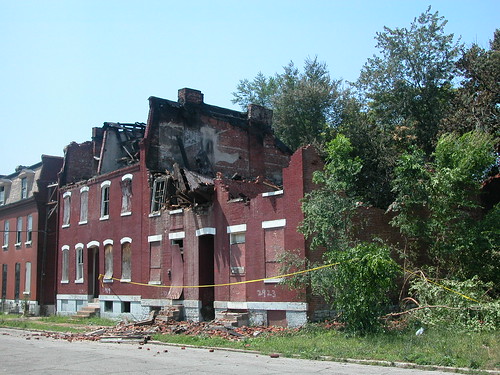 The row of vacant city-owned houses at 2917-25 N. 13th Street in Old North St. Louis on July 20, 2008. A mysterious fire the night before led to the collapse of the northern section.
The row of vacant city-owned houses at 2917-25 N. 13th Street in Old North St. Louis on July 20, 2008. A mysterious fire the night before led to the collapse of the northern section.
UPDATE: The What’s New In Old North blog has posted another Old North progression — this one from decay to new life: “The History and Transformation of Old North, as seen in one building”
 I don’t know if prolific tagger Ed Boxx (also known as Rexx Ram or Red Foxx) is really dead, or if he faked his death as a prank.
I don’t know if prolific tagger Ed Boxx (also known as Rexx Ram or Red Foxx) is really dead, or if he faked his death as a prank.
I don’t know who Ed Boxx really is, and I don’t think that I know anyone who has met him in person.
I have no idea what is meant by “Get Up, Get God.”
I don’t know how I feel about the artist’s use of historic buildings as tablets for his work. Actually, I do. I don’t like it. But I don’t like it a whole lot less than I don’t like property owners letting their buildings deteriorate to the extent where they don’t even try to clean up grafitti.
One thing that I know for certain is that this Ed Boxx piece on the dormitory buidling of St. Mary’s Infirmary captures my attention and admiration. The skyline drawing, the colors, the imitation of the building’s rooftop cross in the work — this is pretty deliberate work. I’d rather not see this work on this building, but that’s not the root problem. Not at all.